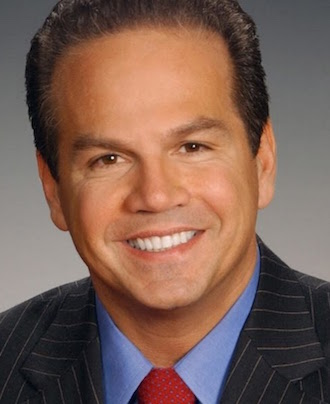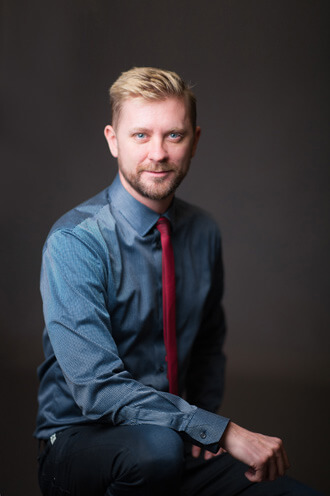Ken Kidd (in black V-neck) hands out the manifesto. | GAY CITY NEWS
A manifesto reading “Still here. Still Queer.” on one side quickly became the must-have accessory during Manhattan’s June 28 Pride Parade. The distributors, a mix of volunteer and paid, were careful to display that side as they traveled the length of Fifth Avenue handing out 7,500 copies. The broadsheet was quickly hung on the barricades that lined the parade route or attached to clothing. A few faces turned to consternation as recipients flipped the manifesto and read “I Hate the Gays.” and “Fuck Homonormativity” on the other side.
“I thought it was important to get those voices out there,” said Ken Kidd, who was among those distributing the manifesto. “These were 14 very strong, very diverse voices that talked about the history of the movement at a watershed moment as well as where we go from here.”
The 14 essays, all authored anonymously, fired at the assimilationist impulse that dominates LGBT politics in 2015. Coming just two days after the US Supreme Court required all states to issue marriage licenses to gay and lesbian couples and to honor the licenses issued to such couples in other states, a decision that for some in the community represents the victory by those who would have LGBT people conform to the dominant culture’s values, the essays reasserted the queer identity as one with fundamental differences from heterosexuality that are valuable and worth celebrating.
To the tune of 7,500 copies, manifesto anonymously attacking assimilationist politics handed out on Fifth Avenue
“It was a particular moment where some would argue we had just won our biggest victory and others would argue it was our biggest concession to assimilation,” Kidd said.
Some of the 14 anonymous essays written for the manifesto. | GAY CITY NEWS
Some of the essays revel in queer sexuality and different identities, or offer pointed, even insulting, critiques of both “homonormativity” and “heteronormativity.”
The authors printed 10,000 copies of the manifesto. In addition to the Pride Parade, they were distributed at the Dyke March, the Drag March, the June 26 rally in the West Village that celebrated the marriage decision, and at other locations in Manhattan.
“The most heartening thing to me was to see how eager young people were to get this,” Kidd said. “We sell these kids short. I will tell you that my experience that whole weekend is that these were the people who were hungry to get it and hungry to get extra copies that they could give to their friends.”
The 2015 broadsheet mirrors one that was distributed in 1990 titled “Queers Read This,” and this year’s manifesto reprinted several portions of that earlier document. The 1990 manifesto was written by “Anonymous queers” and was best known for the essay “I Hate Straights,” which was very controversial in New York City’s LGBT community. The “I Hate the Gays.” essay reflected that earlier piece.
Some in the crowd responded enthusiastically. | GAY CITY NEWS
In a sort of be-careful-what-you-wish-for irony, “I Hate Straights” called for a moratorium on LGBT people participating in heterosexual weddings and related rites or viewing baby pictures until LGBT people could have their own. “I Hate the Gays” chastised the gay and lesbian couples who are marrying and raising children and “imagine that the straight dads and moms don’t talk about them like they’re second-class citizens once the gluten-and-peanut-free cupcakes are gone and the SUV’s doors are shut tight.”
As the 2015 manifesto was handed out, few people read it, but the hope was they would take it home, read it, talk about it with friends, and contemplate it. The few people who were reading it on West 38th Street before the group, which was not officially admitted to the parade, stepped on to Fifth Avenue responded positively.
“I think it’s really interesting,” said Mel, who was seated on the sidewalk and reading it with a friend. “It moves past the conservative binary of gay and lesbian.”
Others studied the manifesto with curiosity. | GAY CITY NEWS
Mary, who was reading the manifesto with two friends, approved, though one friend, Jasmin, was initially unsure if it was a pro-LGBT document. It was “informative” and “good,” said Charles as he stood reading it.
“Sometimes you need to be radical to be heard,” said Mary.
Whether radical politics, which are the origin of the modern LGBT rights movement, still have a place in the movement is the broader question raised by the manifesto. Typically, movements are motivated by grievances and movements are organized around battling those grievances. The LGBT movement has seen a string of recent successes, largely on marriage, culminating in the US Supreme Court decision.
“The fact of the matter is that we owe extraordinary debts to our enemies because almost all of our progress has been in response to things our enemies have done and precious little were things we thought of,” said Ken Sherrill, a professor emeritus of political science at Hunter College. “We were radicalized by the bad things that were done to us. Very few of us are radicalized by manifestos.”
Some of the 14 anonymous essays written for the manifesto. | GAY CITY NEWS
The manifesto could spark an intra-community dispute, which already exists to the degree that the anonymous authors are not the first to resist the marriage movement that presents LGBT people as just like everybody else in America. In Sherrill’s view, coming out is already a “radicalizing experience” and that may be sufficient for most LGBT people today.
“Some people are persuaded that we have an obligation to be radical,” he said. “I think that as much as I love people who try to do this and as much as I try to one of them myself, there are limits to your ability to radicalize… I think the argument is that it takes more to radicalize a gay person today than it took 45 years ago.”





































